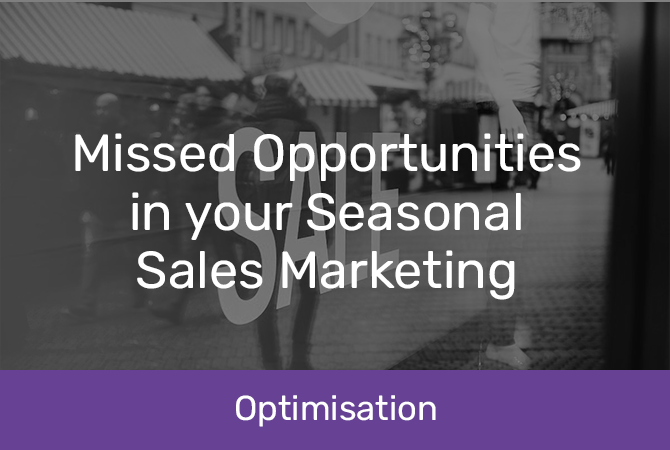
Missed opportunities in your seasonal sales marketing
7 ways to do better next time
While seasonal promotions and sales can be an exciting time for consumers to find a bargain, these periods can be some of the most hectic times for retailers. Seasonal sales such as Black Friday, End of Season sales and Boxing Day are times of massive sales, super-charged marketing and long hours – all condensed into a short, intense timeframe. And it is no wonder why many marketing teams and retail managers just want to rest after these big sales periods.
However, with big sales seasons come big opportunities for growth – and loss. Because sales numbers are so high, any weaknesses or missed details in your marketing during this period have an outsized impact. This means it’s well worth deep diving into your campaign performance, so you’re well-prepped for whatever sales season is in your near future.
Retail campaign analytics count
Campaign analytics should be a standard part of any marketing work – how will you improve otherwise? It can involve ongoing tracking and testing during a campaign and a broader look at performance against campaign metrics after the fact. There are plenty of analytics tools and techniques, either built into your marketing automation platform or through outside providers like Google or Facebook.
Analytics isn’t about placing blame or trashing a campaign – it’s about finding out what worked well and what you could do better next time. Every campaign is a chance to learn more about your target audience, identify new sales leads and marketing opportunities, smooth out processes, find out more about your chosen channels and, ultimately, boost the ROI of your next campaign.
Sale season campaigns often go under or un-analysed. Sometimes it’s a case of marketing teams running out of steam after a busy period or staff simply being out of the office over holiday periods. Whatever the reason, it’s worth taking a good look – or a second look – to ensure you haven’t missed any crucial insights.
Here’s what to look for:
1. Find out where the sales are coming from
Retail used to be simple: visit a store or website, check out the products and make a purchase. Done and done. Now, consumers interact with brands through an average of eight channels, and one in ten purchases happens through a non-traditional channel. Think social media, messaging platforms, sales marketplace, or even a smart speaker powered by Alexa or Google. If you’re focused on pushing consumers to your website above all, you could miss out on a significant portion of potential sales.
Look at the stats to see where your sales are coming from. If one channel – social, for example – seems to stand out, it’s worth putting more energy into that area in your next campaign.
2. Check your emails
Email is underrated as a sales driver, offering the highest ROI of any channel (at around $36 for every $1 spent). During the holiday sale seasons, that impact can be even more substantial, with surveys showing that consumers pay more attention to sales emails around these times of the year. Look closely at the emails you sent – open rates, conversions and A/B testing for different content.
What type of email gets the best response? Is there a specific time or date that correlates with a sales boost? Could you up your emails to drive more sales?
Personalised emails have been shown to increase open rates by 26% ¬– does your data bear that out? Browsing data can help you personalise by consumer activity, while data collected in your CRM can help you personalise by name, area and even birthday.
3. Find micro-moments in browsing
Did you know that 90% of smartphone users aren’t sure what brand they will buy when they start browsing? For retailers, browsing is a huge opportunity to grab attention and draw in buyers. You can use browsing data to work through the ‘micro-moments’ or tiny steps that bring people to your brand. Search terms, click-throughs, engagement and conversions can all help you build a picture of consumer behaviour.
Then, draw on this data for your next campaign. For example, if you see a lot of searches based on gift ideas, you could create ad content or blogs suggesting ideas for specific groups. Consider creating new product categories based on gift suggestions to make your site appealing and pull in those undecided consumers.
4. Assess relevance and retargeting
Browsing isn’t just about searching for your brand – it’s about the consumer wandering around your site and, ideally, buying a product. This process isn’t necessarily straightforward – research shows that almost 70% of online shopping carts are abandoned before the sale is complete. That’s got to be frustrating for retailers.
On the other hand, those abandoned carts give you vital information about potential customers. Knowing the exact product a consumer wants to buy is like gold dust in marketing, so make sure you’re using it wisely. With 45% open rates, email follow-ups can be effective, particularly if you offer a discount code or free shipping as a sweetener. Remarketing, which targets the consumer with ads for a specific product, is another approach.
In your post-seasonal sale analysis, abandoned carts – and follow-ups – should be part of the picture. What percentage of in-cart items are purchased vs abandoned? How well do your follow-up strategies work? For example, do follow-up emails have a better conversion rate than retargeting? Finally, are you using any cart abandonment follow-up strategies at all? If you’re not, it’s definitely worth considering for next year.
5. Is your mobile site slowing you down?
It’s not surprising that mobile has overtaken other devices as the most common way to browse the internet, with 59% of web traffic coming from mobile phones. This means mobile should be your priority in web design – not an afterthought. If you haven’t optimised your site for easy mobile browsing – if the layout doesn’t fit the screen or the font size is unreadable on a phone – people will look elsewhere.
Your website should be easy to navigate, with clear buttons and minimal drop-down menus. It should have phone numbers and contact details in text or link form so people can get in touch easily. Most sites designed for mobile are heavy on images and lighter on text, which can be hard to read on a smaller screen. Put simply, you want to remove any roadblocks to consumers using your website.
One indicator of a site that’s not working for mobile browsers is a high bounce rate on mobile. Bounce rate shows you the percentage of browsers that click away after viewing a single page on your site – if it’s high, it could mean that browsers are turned off by your mobile optimisation. Make sure this metric is part of your post-seasonal sale round-up.
6. seasonal sale specials
Offers and discounts seem like a sure-fire way to boost sales, but it could be more complex than that. Sometimes, this approach cannibalises other sales, meaning similar – or worse – profitability. For example, a pre-Easter sale offer could create a nice bump in your sales numbers during the offer period but lead to lower sales during the rest of the season. In other words, you don’t bring in any new consumers, so you’re just selling to people who’d have bought anyway, but at a lower price.
In the long run, frequent sales and discounts can be a net negative, devaluing your product and prompting consumers to wait for the next sale instead of buying at full price.
Teasing out the impact of a discount takes time and effort. You’re not just looking at sales figures but the volume of products sold in a set period, the price level and profit margin for each and how they compare to a standard week or month of sales.
7. Social media matters
How are your social channels doing? While social media aren’t usually significant sources of direct sales, they can be powerful ways to boost brand awareness, expand your audience and build relationships with customers. At particular times of the year, such as Christmas, when some consumers shop outside their usual buying patterns and look for new ideas, they can be useful tools to get your product out there.
Analysing social performance should focus on the quality of the engagement rather than surface-level metrics – reach, click-through rates and percentage of engaged impressions rather than likes and views. Look at your post frequency, post topics and the type of content that correlates with increased engagement. For example, if video content tends to get the most traction, make sure that’s a key part of your content planning for next year. Look at the type of video too – do you get better engagement with product demos, behind-the-scenes content, or how-to videos?
 Case Study - Retailer Boosts sales and cuts costs with catalogue optimisation
Case Study - Retailer Boosts sales and cuts costs with catalogue optimisation
Catalogue deliveries are a significant sales driver for many retailers – particularly around holiday weekends and seasonal changes. Although in a very general sense catalogue drops are considered ‘direct’ advertising, they have not be accurately targeted in the past and are not personally addressed. In this case a large retailer was preparing to launch its new season stock and wanted to know the optimum areas for catalogue distribution to ensure it achieved highest possible return on investment.
Read more to find out the solution and result we provided for this retailer.
 Looking ahead to future seasonal sale periods
Looking ahead to future seasonal sale periods
Campaign analysis is a key part of the marketing process. When the sakes are higher and the details are more complex at seasonal sale periods, it’s essential to get it right – a fine-tooth-comb approach instead of a quick once-over. Without a meticulous look at the outcomes of your campaign work, you could miss crucial details and opportunities to boost sales next time. The channels you use, your email marketing, abandoned cart follow-ups, the volume of traffic coming through mobile, and the length and timing of your campaign can all help you work out how best to target and convert potential customers. With this information in hand, you can start thinking about when and how to start the next seasonal sales campaign – it will be here sooner than you think.
Of course, data and appropriate analytics tools are the keys to all this analysis. Without those, you won’t be able to gather the information you need, make connections between different data points, and turn those into valuable insights. And that’s where Datamine comes in. We’re data devotees from way back, with decades of experience turning raw data into actionable information. If you’re not sure where to start in your post-seasonal sales campaign analysis, we can help.
At Datamine, we work with clients across Australia and New Zealand in almost every sector. Get in touch- Talk to the team at Datamine to get started.















































